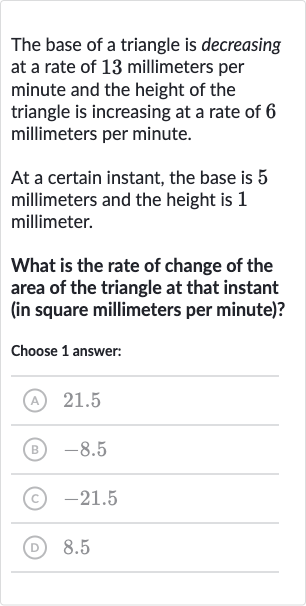AI tutor
Welcome to Bytelearn!
Let’s check out your problem:

The base of a triangle is decreasing at a rate of millimeters per minute and the height of the triangle is increasing at a rate of millimeters per minute.At a certain instant, the base is millimeters and the height is millimeter.What is the rate of change of the area of the triangle at that instant (in square millimeters per minute)?Choose answer:(A) .(B) .(C) .(D) .
Full solution
Q. The base of a triangle is decreasing at a rate of millimeters per minute and the height of the triangle is increasing at a rate of millimeters per minute.At a certain instant, the base is millimeters and the height is millimeter.What is the rate of change of the area of the triangle at that instant (in square millimeters per minute)?Choose answer:(A) .(B) .(C) .(D) .
- Calculate Initial Area: Now, let's calculate the initial area of the triangle with the given base and height.Area = .
- Find Rate of Change: To find the rate of change of the area, we'll use the formula for the derivative of the area with respect to time, , where is the rate of change of the base and is the rate of change of the height.
- Plug in Values: We know (since the base is decreasing) and (since the height is increasing). Let's plug these values into the formula. .
- Perform Calculation: Now, let's do the calculation..
More problems from Calculate unit rates with fractions
QuestionGet tutor help
QuestionGet tutor help
QuestionGet tutor help
QuestionGet tutor help
QuestionGet tutor help
QuestionGet tutor help
QuestionGet tutor help
QuestionGet tutor help
QuestionGet tutor help
